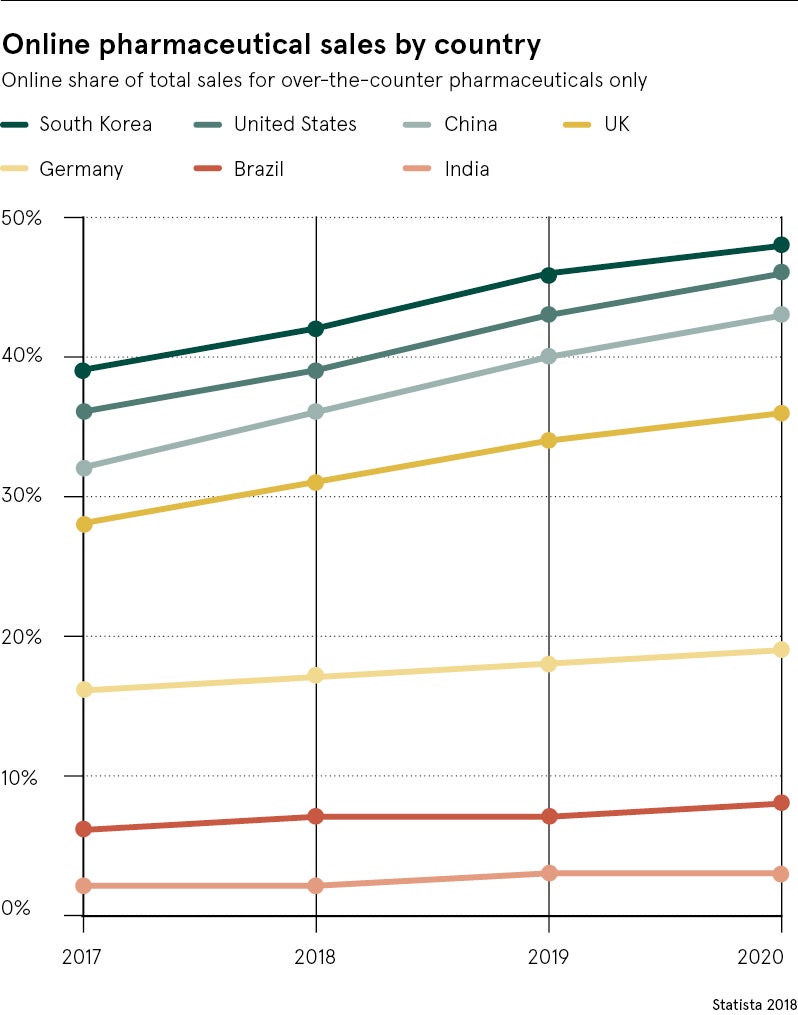More than a billion prescriptions are dispensed by the NHS every year, and most are delivered with a reassuring reverence and over-the-counter simplicity by community pharmacies.
But the white paper bags, blister packs and the weekly pill boxes that are prime features of the medical landscape are being shaken by a disruptive earthquake from medication ordered online and delivered in pre-sorted pouches.
Whether the NHS will opt to partner with firms like Amazon is up for debate
With a growing global population and predictions that the over-65 age group will rise from 22 to 28 per cent by 2030, the number of prescriptions will continue to rise and present opportunities for different delivery models.
Amazon sets its sights on prescriptions
Online pharmacies are not new, but when the retail giant Amazon enters a market, it is clear that rapid change will follow. The company has just signalled its burgeoning pharmaceutical ambitions by purchasing the company PillPack for around $1 billion.
PillPack’s founders, from a pharmacy and technology engineering background, focused on the booming number of adults taking five or more prescriptions. In the United States, this cohort has reached one in ten, or 30 million adults, while research by Omnicell reported that five million patients in the UK are taking four or more types of drugs.
Its approach, delivering pouched monthly supplies of medicines in a user-friendly dispenser along with labels that have pictures of each pill and notes on how to take them, has taken the market by storm and attracted the massive price tag Amazon was willing to play.
The sale indicates a wider shift in medication packaging with companies switching on to the power of design and delivery to both make it easier for patients to stick to their dosage and to increase significantly the number of people who comply with their prescriptions.
Better design and user experience is needed for prescriptions
The UK already has its own version, PillTime, which is gathering momentum and helping to reduce the level of medication errors – 237 million in the UK annually with 66 million serious enough to cause patient harm, according to a 2018 study by the universities of York, Manchester and Sheffield – and the burden of patients failing to take their medicine, which costs the NHS £98.5 million a year, according to the study.
Pill packaging has been a design backwater with few changes since the 1980s, but it is catching the eye of a number of innovative companies.
“Pharmaceutical products and many consumer health medicines provide below-par consumer experiences,” says Chris Houghton of the Cambridge Design Partnership, which developed the innovative single-use BeeBetter pouch to deliver oral medication.
“Decades of standardisation and implementing cost-saving efficiencies have left the category bereft of any genuine consumer empathy or packaging design innovation,” he says.
“With an ageing population, designs need to be inclusive and factor in difficulties people may have reading instructions or handling child-resistance closures. For other age groups there are issues such as convenience, money-saving, singled-handed use and sustainability.
“How blister packs are deemed ‘fit for purpose’ puzzles me because they have a mix of non-recyclable plastic and metal materials, and many children can open the so-called children resistance feature while the elderly, who need them most, often struggle.”
How high street pharmacies are adapting to online competition
The broadening of online pharmacy capabilities could have an impact on high street pharmacies, but they have responded by adapting and growing their clinical influence over the last decade, providing more face-to-face advice to the public, and becoming venues for screening and testing programmes as well as their dispensing duties.
“We don’t see it as a threat. Any market is potential for disruptive entry, but there are already the beginnings of pharmacies looking at how they can play in this space,” says Malcolm Harrison, chief executive of the Company Chemists’ Association, which represents the major high street chains, with 6,000 outlets dispensing more than 500 million NHS prescription items every year.
“The way in which people want products and services is very different to the past. If you want a taxi, you go to Uber; if you want a takeaway, you go to Just Eat. People bank on their mobile phones and holidays are through Airbnb. Pharmacies need to be aware of this.
Amazon pushing pharmacies to up their level of care
“We still need bricks-and-mortar pharmacies that provide face-to-face care. There are a growing number of people with long-term conditions, and we are getting older and living longer with ill health.
“Although some things can be delivered digitally, some can’t, so how we can embrace the new to facilitate meeting new demands is important. Community pharmacies play a huge role in this, not only in long-term care, but also in helping deal with high-volume, low-acuity care that would normally take patients to the GP or the A&E unit.”
Ruchin Kansal, healthcare leader of digital business strategy at IT services specialists Virtusa, believes Amazon’s move is creating seismic change in pharmacy delivery. “Whether the NHS will opt to partner with firms like Amazon is up for debate,” he says.
“But the reality is that, even if pouch packaging is strictly limited to online-use through non-NHS providers when it takes off in the UK, it represents Amazon’s mission to make the life of their customers easier, from retail to medication consumption.”
Amazon sets its sights on prescriptions
Better design and user experience is needed for prescriptions


